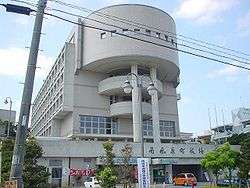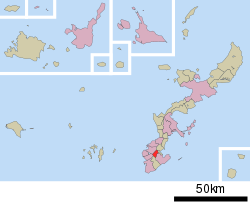Haebaru, Okinawa
Haebaru (南風原町, Haebaru-chō, Okinawan: フェーバル Feebaru[1]) is a town located in Shimajiri District, Okinawa Prefecture, Japan.[2]
Haebaru 南風原町 | |
|---|---|
Town | |
 | |
Flag Emblem | |
 Location of Haebaru in Okinawa Prefecture | |
 Haebaru Location in Japan | |
| Coordinates: 26°11′28″N 127°43′43″E | |
| Country | Japan |
| Region | Kyushu |
| Prefecture | Okinawa Prefecture |
| District | Shimajiri |
| Area | |
| • Total | 10.72 km2 (4.14 sq mi) |
| Population (October 1, 2016) | |
| • Total | 37,874 |
| • Density | 3,500/km2 (9,200/sq mi) |
| Symbols | |
| • Tree | Ebony |
| • Flower | Bougainvillea |
| Time zone | UTC+9 (JST) |
| City hall address | 686 Aza Kanegusuku, Haebaru-chō, Shimajiri-gun 901-1195 |
| Website | www |
As of 2016, the town has an estimated population of 37,874 and a density of 3,500 persons per km². The total area is 10.72 km². It is one of the only landlocked towns in Okinawa, but its central location ensures traffic and business remain healthy.
Haebaru is located in the south of Okinawa Island directly southeast of the prefectural capital of Naha.[2]
Haebaru is home to several pachinko parlors, as well as a skate and BMX ramp under the Okinawa Expressway. There is a large ÆON shopping complex and hypermarket.
Haebaru is the birthplace of Ultraman, a fictional television character that grows to a giant size and wrestles with giant monsters. The town is also home to a traditional Ryukyuan craft producing woven fabric or kasuri. It is produced at workshops in Haebaru.[3]
In June 2007 dugout bunkers used as military hospitals during the 1945 Battle of Okinawa were opened to the public for tours. In spring 2011, local junior high students began training as peace tour guides in a work experience program aiming to guide members of the public around the caves.[4]
Culture
Haebaru Town Museum
The Haebaru Town Museum is located in the Kiyan district of Haebaru directly west of the site of the Haebaru Japanese Army Hospital. The museum features a reproduction of the facilities of the dugout bunkers that were used for the army hospital. In addition to other wartime artifacts, the museum has exhibits on traditional pre-war Okinawan life and overseas emigrants from the town.[5][6]
Okinawa Prefectural Archives
Haebaru is home to the Okinawa Prefectural Archives (OPA). OPA was established on April 1, 1995 as a result of the Japanese Public Archives Act of 1988. The archive seeks to collect and preserve the official documents and historical records of Okinawa Prefecture. OPA collects historical materials and records of the Ryukyu Kingdom, the Government of the Ryukyu Islands, the United States Civil Administration of the Ryukyu Islands (USCAR), and the present-day Okinawa Prefectural Government.[2][7] In 2011 OPA had 12,595 visitors annually.
Notable People
- Yuken Teruya, artist
| Wikimedia Commons has media related to Haebaru, Okinawa. |
References
- 滝原康盛 Takihara Yasumori. 沖縄語会話集 日本語・沖縄語・ローマ字付き Okinawago Kaiwashū: Nihongo, Okinawago, Rōmaji-tsuki. (Okinawan Conversation Collection: Japanese, Okinawan, Romaji.) 那覇:沖縄芸能出版 Naha: Okinawa Geinō Shuppan. Heisei 6 (1994). p. 108. (in Japanese)
- "南風原(町)" [Haebaru]. Nihon Daihyakka Zensho (Nipponika) (in Japanese). Tokyo: Shogakukan. 2013. OCLC 153301537. Archived from the original on 2007-08-25. Retrieved 2013-01-09.
- "Archived copy". Archived from the original on 2012-03-24. Retrieved 2011-09-01.CS1 maint: archived copy as title (link)
- http://english.ryukyushimpo.jp/2011/06/22/1417/
- "Haebaru Town Museum". Urasoe, Okinawa Prefecture, Japan: Okinawa2Go!. 2011. Retrieved 2013-01-09.
- 南風原文化センター [Haebaru Town Museum] (in Japanese). Haebaru, Okinawa Prefecture, Japan: Town of Haebaru. Retrieved 2013-01-09.
- "An introduction to the Okinawa Prefectural Archives". Haebaru, Okinawa Prefecture, Japan: Okinawa Prefectural Archives. 2008. Archived from the original on 2013-01-30. Retrieved 2013-01-09.
